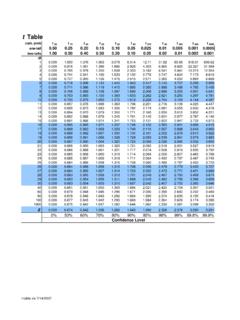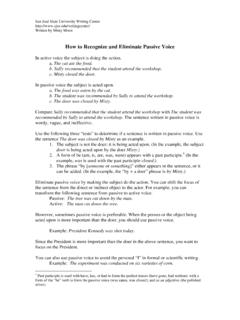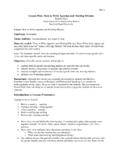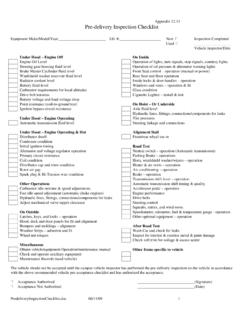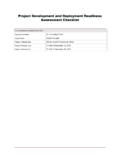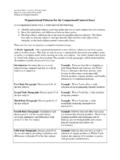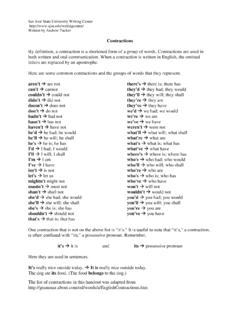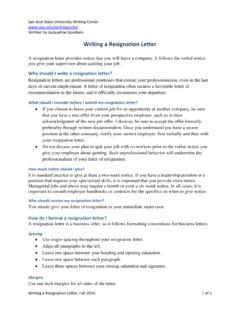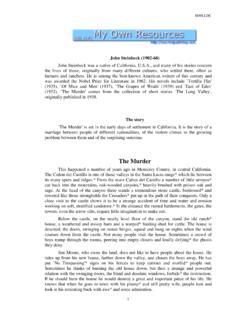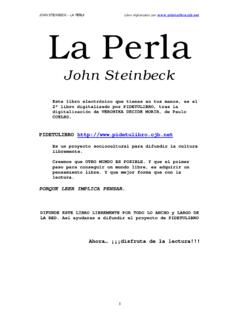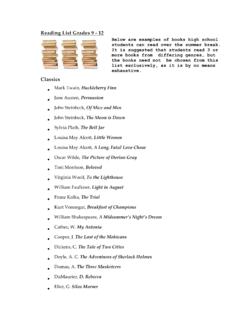Transcription of Biography in Depth: John Steinbeck, American Writer by Dr ...
1 Biography in depth : john steinbeck , American Writer by Dr. Susan Shillinglaw john steinbeck was born in the farming town of Salinas, California on 1902 February 27. His father, john Ernst steinbeck , was not a terribly successful man; at one time or another he was the manager of a Sperry flour plant, the owner of a feed and grain store, the treasurer of Monterey County. His mother, the strong-willed Olive Hamilton steinbeck , was a former teacher. As a child growing up in the fertile Salinas Valley called the "Salad Bowl of the Nation" steinbeck formed a deep appreciation of his environment, not only the rich fields and hills surrounding Salinas, but also the nearby Pacific coast where his family spent summer weekends.
2 "I remember my childhood names for grasses and secret flowers," he wrote in the opening chapter of East of Eden. "I remember where a toad may live and what time the birds awaken in the summer-and what trees and seasons smelled like." The observant, shy but often mischievous only son had, for the most part, a happy childhood growing up with two older sisters, Beth and Esther, and a much-adored younger sister, Mary. Never wealthy, the family was nonetheless prominent in the small town of 3 000, for both parents engaged in community activities. Mr. steinbeck was a Mason, Mrs.
3 steinbeck a member of the Order of the Eastern Star and founder of The Wanderers, a women's club that traveled vicariously through monthly reports. While the elder Steinbecks established their identities by sending roots deep in the community, their son was something of a rebel. Respectable Salinas circumscribed the restless and imaginative young john steinbeck and he defined himself against "Salinas thinking." At age fourteen he decided to be a Writer and spent hours as a teenager living in a world of his own making, writing stories and poems in his upstairs bedroom.
4 To please his parents he enrolled at Stanford University in 1919; to please himself he signed on only for those courses that interested him: classical and British literature, writing courses, and a smattering of science. The President of the English Club said that steinbeck , who regularly attended meetings to read his stories aloud, "had no other interests or talents that I could make out. He was a Writer , but he was that and nothing else" (Benson 69). Writing was, indeed, his passion, not only during the Stanford years but throughout his life. From 1919 to 1925, when he finally left Stanford without taking a degree, steinbeck dropped in and out of the University, sometimes to work closely with migrants and bindlestiffs on California ranches.
5 Those relationships, coupled with an early sympathy for the weak and defenseless, deepened his empathy for workers, the disenfranchised, the lonely and dislocated, an empathy that is characteristic in his work. After leaving Stanford, he briefly tried construction work and newspaper reporting in New York City, and then returned to his native state in order to hone his craft. In the late 1920s, during a three-year stint as a caretaker for a Lake Tahoe estate, he wrote several drafts of his first novel, Cup of Gold (1929) about the pirate Henry Morgan, and met the woman who would become his first wife, Carol Henning, a San Jose native.
6 After their marriage in 1930, he and Carol settled, rent-free, into the steinbeck family's summer cottage in Pacific Grove, she to search for jobs to support them, he to continue writing. During the decade of the 1930s steinbeck wrote most of his best California fiction: The Pastures of Heaven (1932), To a God Unknown (1933), The Long Valley (1938), Tortilla Flat (1935), In Dubious Battle (1936), Of Mice and Men (1937) and The Grapes of Wrath (1939). To a God Unknown, second written and third published, tells of patriarch Joseph Wayne's domination of and obsession with the land.
7 Mystical and powerful, the novel testifies to steinbeck 's awareness of an essential bond between humans and the environments they inhabit. In a journal entry kept while working on this novel - a practice he continued all his life the young author wrote: "the trees and the muscled mountains are the world but not the world apart from man the world and man the one inseparable unit man and his environment. Why they should ever have been understood as being separate I do not know." His conviction that characters must be seen in the context of their environments remained constant throughout his career.
8 His was not a man-dominated universe, but an interrelated whole, where species and the environment were seen to interact, where commensal bonds between people, among families, with nature were acknowledged. By 1933, steinbeck had found his terrain; had chiseled a prose style that was more naturalistic, and far less strained than in his earliest novels; and had claimed his people - not the respectable, smug Salinas burghers, but those on the edges of polite society. steinbeck 's California fiction, from To a God Unknown to East of Eden (1952) envisions the dreams and defeats of common people shaped by the environments they inhabit.
9 Undoubtedly his ecological, holistic vision was determined both by his early years roaming the Salinas hills and by his long and deep friendship with the remarkable Edward Flanders Ricketts, a marine biologist. Founder of Pacific Biological Laboratories, a marine lab eventually housed on Cannery Row in Monterey, Ed was a careful observer of inter-tidal life: "I grew to depend on his knowledge and on his patience in research," steinbeck writes in "About Ed Ricketts," an essay composed after his friend's death in 1948 and published with The Log from the Sea of Cortez (1951).
10 Ed Ricketts's influence on steinbeck , however, struck far deeper than the common chord of detached observation. Ed was a lover of Gregorian chants and Bach; Spengler and Krishnamurti; Whitman and Li Po. His mind "knew no horizons," writes steinbeck . In addition, Ricketts was remarkable for a quality of acceptance; he accepted people as they were and he embraced life as he found it. This quality he called non-teleological or "is" thinking, a perspective that steinbeck also assumed in much of his fiction during the 1930s. He wrote with a "detached quality," simply recording what "is.

